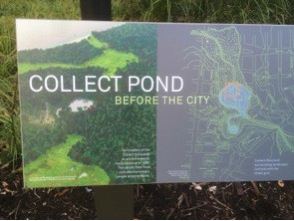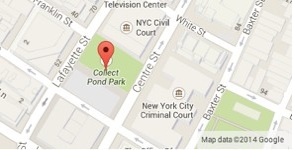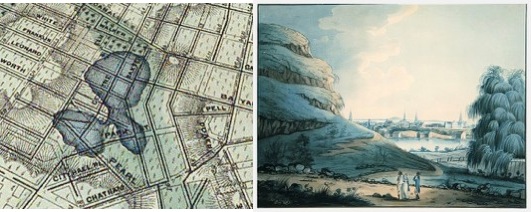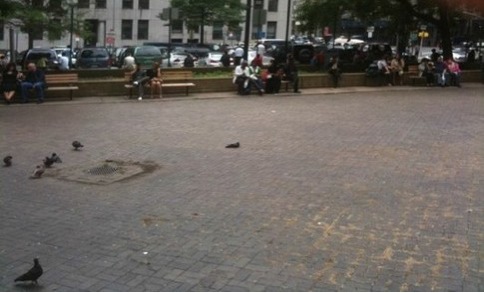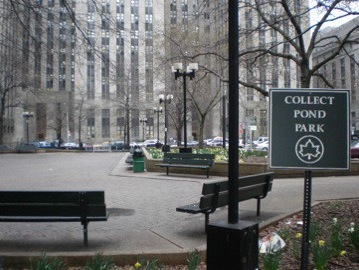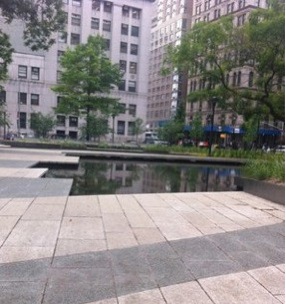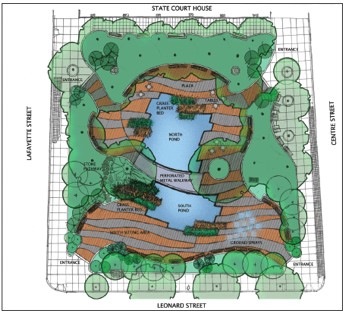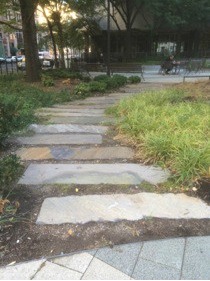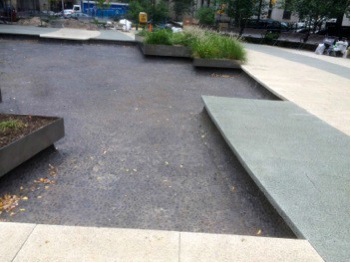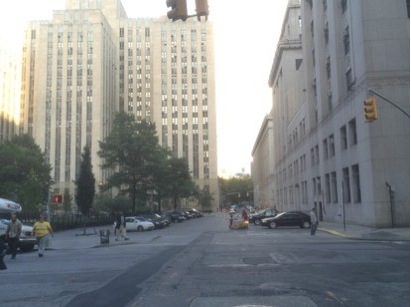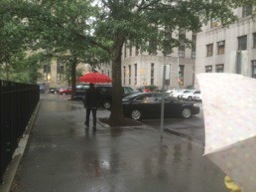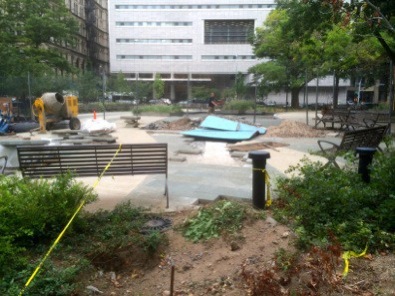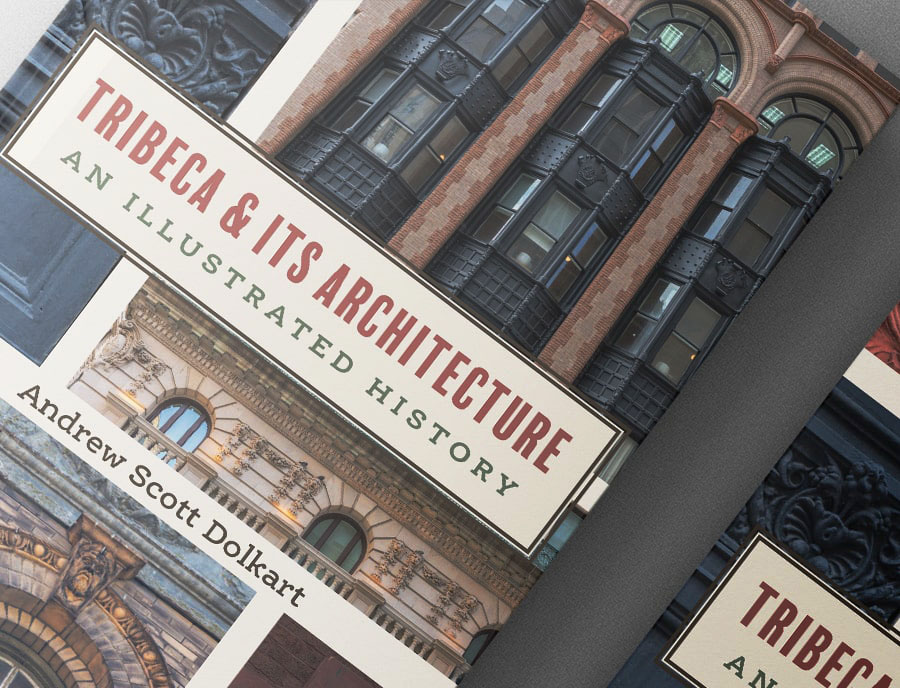The Parks Department opened the gates in the early fall of 2014 for the redesigned “new” Collect Pond Park on the eastern edge of Tribeca. This review of the new design is by Troy Torrison, a board member of Tribeca Trust and a Tribeca parent. He lives in Tribeca East Historic District.
The area south of Canal Street, where the current Collect Pond Park is located, was very different long ago. According to the descriptions of early settlers and some surviving engravings, the Collect Pond area was downright bucolic. The pond once sprawled over 48 acres. Its waters went as deep as 60 feet. People skated here in winter and held picnics in summer. Businesses and homes located beside the spring-fed waters as the city grew.
But the growing city and businesses meant the pond had to die. The surrounding hills were razed. Streets were cut through the swamps and brush. Eventually the area come to house the poor of the infamous ‘Five Points’ neighborhood.
The Old Collect Pond Park
The old Collect Pond Park most New Yorkers remember from serving jury duty nearby was a windswept, raised plaza in the ‘Brutalist’ style. It was a place loved only by rats and pigeons. It was a park so unloved it spawned a recent redesign to replace the blank expanses, heaving pavers and sinkholes.
The park itself takes up almost exactly one acre of precious Manhattan real estate. By comparison, beloved Gramercy Park, a few dozen blocks north, takes up two acres. The park has also been lightly used in the past. Aside from the court workers, cops and those serving on jury duty, the park attracted a relatively large number of homeless New Yorkers and patrons of the various charity services in the area. When the park underwent its long renovation, these folks relocated. Today the park appears to have fewer permanent homeless guests but the shopping carts haven’t vanished and are a reminder that even so close to tony Tribeca and SoHo and bustling Chinatown, there is extreme poverty in New York. Above are two photos of the “old” Collect Pond Park.
A new design for a new Collect Pond Park
Collect Pond Park’s renovation began in the first decade of the new century—and is still ongoing. The main goal of the design was to bring the ‘pond’ back to Collect Pond park. Here is what the Parks Department said about their intentions:
“This park will be closed to transform it into a lush green space with a reflecting pool and other elements that will evoke the large pond here that served as a source of fresh water for the early residents of lower Manhattan. An interactive spray shower will provide recreational opportunities in a community where they are greatly needed. A plaza with benches and tables will attract workers and jurors during lunchtime as well as others attending the surrounding courthouses and community residents. The new park also will include a pedestrian bridge over the pool, decorative pavements, plantings, lighting, bicycle racks, drinking fountains, trash receptacles, fencing and gates. The former parking lot will be incorporated into the park. Anticipated Completion Date, 2013.”
The new pond in question is a few inches deep and lined with concrete embedded with river pebbles to give it a somewhat natural look. The ‘wavy gravy’ pavement style is meant to convey a sense of the hydrological and geological goings-on beneath the surface. It’s not a bad effort, but the park ultimately is just ornamental. It’s a park for sitting in and looking at—for strolling through and not much more. The park offers little to attract families with children in the area. There are no small radio-controlled sailboats or geese waiting to use it. No dogs, no Tai Chi folks, no frolicking kids. The park is designed to look good from a helicopter or out a window. And it’s currently failing at the one purpose it is mainly designed to perform: to be a thing of beauty. The water feature is already broken and the pond is now drained of water.
This evocation of water was clearly the point of the recent renovation, but accomplishing that goal where there was once a 60-foot deep natural pond is easier said than done. The water in this new pond -when it was there- made no sound and had no visible movement. It presented a glassy surface to reflect the buildings and trees. The concrete at the water’s edge cantilevers over the water like a diving platform for small rodents. It’s self-consciously arty—all jagged angles and intentionally artificial cliff-like edges. The design avoids the ‘squaresville’ Beaux Arts work of Calvert & Vaux and updates the ‘straight lines’ approach of modernist parks. Aesthetically, it tries hard to be modern. But not even the ‘groovy’ pavement colors make the place feel special. The design has a curiously indoors look, like something one might see in a shopping mall atrium. Or a Hilton Garden Inn. No doubt in 20 years, this will scream “early 2000’s”. The new Collect Pond Park was designed explicitly to not feel like nature. It shows “grass” and “water” and “nature” only in quotes.
You can see an image of the new pond below and the “wavy” pathway. These photos were taken when the pond had water just after the opening ceremony of the park, before the water was drained.
Why such a design?
It’s about pseudo landscape architecture.
The new style of the park quotes some of the terribly-in-vogue styles of park design these days: Landscape Urbanism (LU). That sobriquet has been thrown around a lot to describe the very successful High Line project. It’s hard to nail down what LU ideas are (their jargon-filled literature makes a fine sleep aid) but it boils down to making places for plants and people that feel ‘modern’ and not old-fashioned. Landscape Urbanists seem to have made peace with cars. They love using the look of the underlying water table in their designs and they tend to put people on to ‘tracks’ so they don’t damage the native grasses and ‘authentic’ plantings rather than using ‘false’ park tropes like hearty, city-friendly trees and ‘simulated’ natural places a la Central Park.’ The High Line is sui generis and hard to criticize on any aesthetic level but here, at Collect Pond, the LU vocabulary seem far less successful. Even at the Collect Pond’s grand re–opening it seemed filled with dazed people not knowing what to do.
There are some things to like in the new park. The western edge has some lovely stone pavers, like this path (seen to the left) that recalls rustic New York park motif.
But look in the photo below a stretch on the northern edge of the newly renovated park. There is a trash dump surrounded by broken chain link fencing. The large line up of healthy, older shade trees were preserved in the recent renovation, but the cost of their survival appears to be their use as a dump.
No Water for the New Pond
Today the water feature has no water, save for small puddles of rain water. Even the birds prefer taking baths elsewhere. Repairs on the broken water supply seem to have stopped as of September 2014 with no word on when they’ll resume. In the meantime, the large expanse of concrete seems all the larger. The tidy planter pods provide some sense of nature but are also framed by geometric quotation marks.
What have we lost? Not much. The unloved old version of the park violated just about every rule of thumb on how to design a good public space. Pigeons and rats used the old park more than humans. It was windswept and ugly.
But we did lose an opportunity
As you look east down Leonard Street you see the south edge of the park (see next photo below). And what a large edge! This has to be one of the widest one way streets in Manhattan. Why such a wide right of way when there’s so little traffic at even the busiest of times? This stretch of pavement looks wide enough to host a local flea market and free concerts. But no. It connects little used Centre Street (and the lovely Columbus Park beyond) to barely busier Lafayette Street in the foreground. The street mainly acts as a parking lot for police as well as municipal and court workers. The vehicles here sport placards on the dashboard allowing free parking–so it’s no wonder the spaces are filled. This is a wide parking lot masquerading as a street. It’s an epic waste of space that should be repurposed to serve more needs of the larger community and not just a lucky few well-connected commuters. The parking lot on the southern edge (see photo below to the right) no doubt has its share of VIP’s who prevented the reclaiming of Leonard Street for green space.
Potential liability lawsuits probably ruled out a ‘real pond’ or even something that looked like a real pond along the lines of the ponds in Central Park. The complexity of the water feature’s pumps and pipes meant when those failed the jackhammers had to be called in. An easy fix seems to be elusive—the pond, which delayed the opening of the park by many months—has now been dry longer than it held water. And the designers favored concrete stylings over trees or making a place something besides a backdrop.
What Next?
I walk through or around this park at least twice a day. It’s in a pretty tragic stage at the moment, but I’m sure it’s fixable. As of September 2014 there is a lot of construction equipment but no actual construction (or re-construction) work happening. Since the park’s purpose is ornamental there isn’t much outcry from the neighborhood who have so little at stake. “Why get bent out of shape about some ugly work happening…there’s been work happening on that park for the last 5 years!”
Maybe the next go-round (in a few decades) will give the community a park we deserved in the first place. A place that’s larger, allows more uses—outdoor concerts, a play area for kids, farmers’ and flea markets—and maybe, if we’re lucky, an actual pond instead of one presented in oh-so trendy Landscape Urbanist quotation marks. With all the condos rising along Broadway the area will almost certainly have more residents in the near future. Perhaps someday there will be a park here to hold their interest. It will be a long wait. Mayor De Blasio recently proposed $130 million fund to help the city’s neediest parks. Collect Pond wasn’t on the list.

